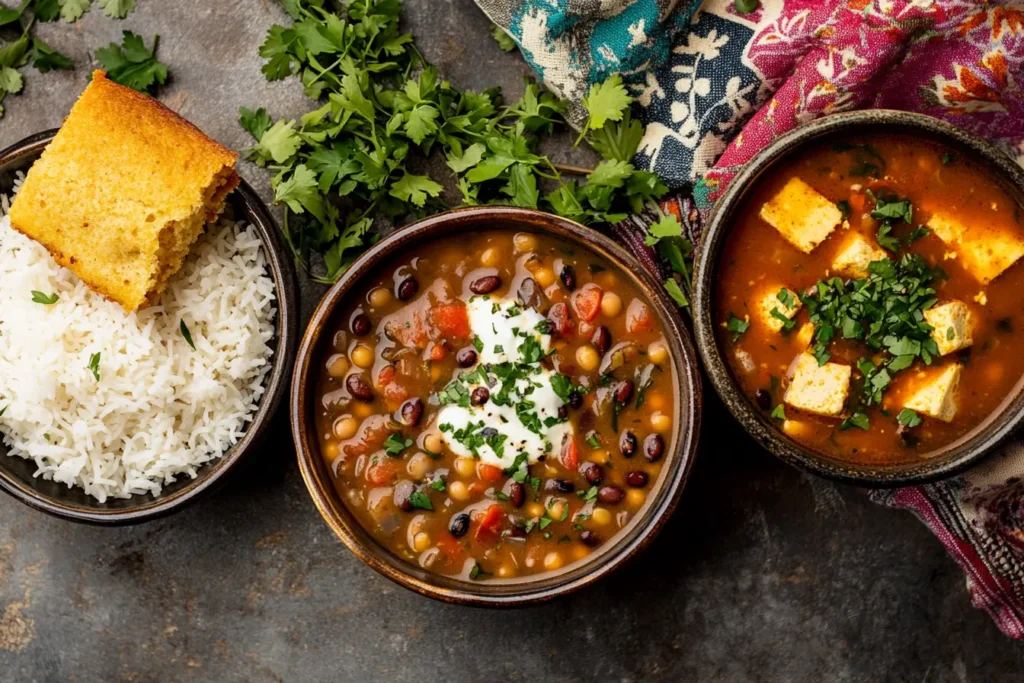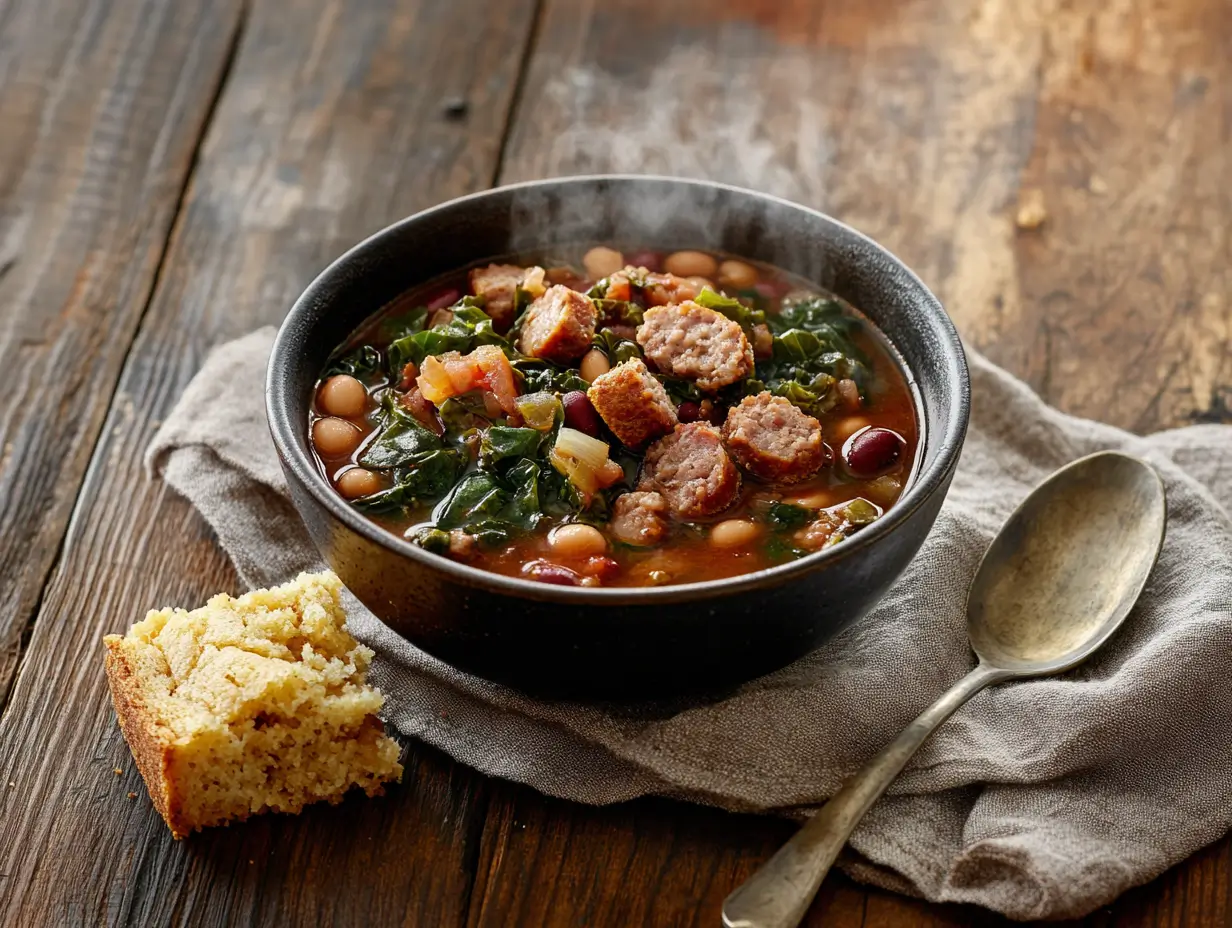Swamp soup might not sound glamorous, but don’t judge this dish by its name. This Southern staple is a delightful combination of hearty, comforting ingredients that blend into a dish bursting with flavor. With roots in traditional Southern cuisine and a viral moment on social media, it has quickly become a must-try recipe for home cooks. Whether you’re looking to try something new or seeking a comforting meal for chilly nights, it is a dish that delivers on all fronts. Let’s explore why this humble soup has taken the culinary world by storm.
Swamp soup’s appeal lies not only in its taste but also in its simplicity and versatility. Originating in Alabama and the Gulf Coast region, it embodies the best of Southern cooking: hearty ingredients, rich flavors, and a soul-warming quality that keeps you coming back for more. It’s also a dish that has found its way into kitchens across the globe, thanks to its viral fame. So, what exactly is swamp soup, and why should you give it a try? Keep reading to uncover the secrets of this Southern gem.
What Is Swamp Soup?
This soup is a rustic, brothy dish that combines smoky sausage, earthy greens, savory beans, and rich broth into a comforting meal. Its signature green, slightly murky appearance, reminiscent of a swamp, gives the dish its playful name. Despite its appearance, it is packed with flavor and is as nourishing as it is delicious.
Key ingredients include smoked sausage, often Conecuh sausage for its Alabama roots, along with collard greens or turnip greens, navy beans, Great Northern beans, and chicken broth. The soup is typically seasoned with garlic, onions, and hot sauce, giving it a zesty kick. What makes this soup truly special is its versatility. It can be customized to suit different preferences, such as substituting smoked sausage with rotisserie chicken or using vegetable broth for a vegetarian version.

Culturally, swamp soup is a cornerstone of Southern cuisine. It’s a dish that symbolizes comfort, resourcefulness, and community. Traditionally served at family gatherings or community events, it reflects the Southern tradition of turning simple, humble ingredients into something extraordinary. Swamp soup’s cultural significance is as rich as its flavor, making it a true staple of soul food.
For insights into other popular Southern dishes, check out this recipe for Southern Cornbread Recipe, a perfect side dish for Swamp Soup.
Why Swamp Soup Went Viral
Social media has a way of making even the most unassuming dishes famous, and it is no exception. Its name alone piques curiosity, while its rustic appeal and hearty nature make it a star among food lovers. Platforms like TikTok and Instagram have turned it into a trending recipe, with countless variations popping up online.
Videos showcasing the preparation of this soup, complete with its vibrant greens and simmering broth, have garnered millions of views. Bloggers and influencers have embraced the dish, sharing their tips and twists, often accompanied by hashtags like #SwampSoup and #SouthernCooking. This viral fame has introduced swamp soup to a new generation of food enthusiasts eager to try their hand at this comforting dish.
What makes this soup especially relatable is its simplicity. In a world of complex, multi-step recipes, swamp soup offers a refreshing alternative. It’s a one-pot meal that’s easy to prepare, making it perfect for weeknight dinners or family gatherings. Its hearty, brothy nature also makes it ideal for cold weather, adding to its widespread appeal. Notably, chefs and food bloggers like Meredith Hayden have shared their versions of swamp soup, further fueling its popularity. This blend of tradition and modern influence has solidified swamp soup as a viral culinary sensation.
A History of Swamp Soup in Southern Cuisine
Swamp soup has a long-standing history in Southern cuisine, particularly in Alabama and the Gulf Coast region. Its origins can be traced back to the practice of using whatever ingredients were available to create a nourishing meal. This resourceful approach led to the development of a dish that combined greens, beans, and sausage into a hearty soup.
Traditionally, swamp soup was a way to make use of leftovers, turning scraps into something delicious and satisfying. Over time, the dish evolved to include smoked sausage, a key ingredient that adds depth and richness to the flavor. Conecuh sausage, a favorite in Alabama, is often used, giving the soup its distinctive smoky taste. Alongside the sausage, collard greens or turnip greens add an earthy note, while beans like navy beans or Great Northern beans provide texture and protein.
It became a popular dish at community gatherings, church potlucks, and family dinners, cementing its place in Southern culture. Restaurants like Fish River Grill in Alabama have also played a role in popularizing swamp soup, introducing it to diners outside the region. Today, the dish remains a beloved part of Southern tradition, celebrated for its heartwarming qualities and ability to bring people together around the table.
The Recipe: How to Make Swamp Soup
If you’re ready to experience the magic of swamp soup, here’s a step-by-step guide to making this delicious dish at home. This recipe is simple, customizable, and perfect for both beginners and seasoned cooks.
Ingredients
- 1 pound smoked sausage, sliced (Conecuh sausage recommended)
- 4 cups collard greens, chopped (or turnip greens)
- 1 can (15 oz) navy beans, rinsed and drained
- 1 can (15 oz) Great Northern beans, rinsed and drained
- 4 cups chicken broth (or vegetable broth for a vegetarian version)
- 1 medium onion, diced
- 2 cloves garlic, minced
- 1 tablespoon olive oil
- 1 teaspoon hot sauce (optional)
- Salt and pepper to taste

Step-by-Step Instructions
- Brown the Sausage: Heat olive oil in a large pot over medium heat. Add the sliced sausage and cook until browned, then remove and set aside.
- Sauté Aromatics: In the same pot, sauté the onion and garlic until fragrant and translucent.
- Add Greens: Stir in the collard greens and cook until slightly wilted, about 3–4 minutes.
- Combine Ingredients: Return the sausage to the pot and add the beans, broth, and hot sauce. Stir to combine.
- Simmer: Bring the soup to a boil, then reduce the heat and let it simmer for 30–45 minutes to allow the flavors to meld.
- Season and Serve: Adjust the seasoning with salt and pepper. Serve hot with cornbread for the perfect Southern meal.
Customization Tips
- Vegetarian Option: Replace the sausage with plant-based alternatives and use vegetable broth.
- Add Grains: Include cooked jasmine rice or pasta for a heartier soup.
- Spice It Up: Add red pepper flakes or extra hot sauce for more heat.
Swamp soup is a dish that invites creativity, so don’t hesitate to experiment with different ingredients to make it your own.
If you’re looking for another hearty soup recipe, you might enjoy the Black Bean Soup Recipe, which offers a similarly nourishing profile.
The Appeal of Swamp Soup: Comfort Food at Its Finest
Swamp soup is the epitome of comfort food. Its hearty, brothy consistency and layered flavors make it the perfect meal for chilly evenings or family gatherings. The combination of smoky sausage, earthy greens, and savory beans creates a flavor profile that is both satisfying and nostalgic.
Beyond its taste, this soup offers a range of health benefits. Greens like collards and turnip greens are packed with vitamins A and C, while beans provide fiber and protein. This makes it a nutrient-dense dish that is both delicious and good for you. It’s a great way to incorporate more vegetables into your diet without sacrificing flavor.
What truly sets swamp soup apart is its ability to bring people together. It’s a dish that represents community, resilience, and the joy of sharing a meal. Whether you’re enjoying it with family, friends, or even by yourself, swamp soup has a way of making you feel connected and comforted.
Want to elevate the flavors in your soups? Discover tips for making your soups taste extraordinary in this guide: What Gives Soup the Best Flavor.
Is Swamp Soup Traditional, Modern, or Both?
Swamp soup is a unique blend of tradition and modernity. Its roots lie in Southern culinary traditions, but its viral fame has given it a fresh, contemporary twist. This dual identity is part of what makes swamp soup so special.
Traditionalists appreciate swamp soup for its history and cultural significance, while modern food lovers are drawn to its versatility and simplicity. This balance ensures that swamp soup remains a beloved dish for both chefs and home cooks alike.
Swamp Soup pairs wonderfully with cornbread, making it a complete meal. For a Southern-style twist, try serving it with Southern-Style Unsweetened Cornbread or Ranch Taco Soup Recipe for a flavor-packed variation.
Personal Connection: Why I Love Swamp Soup
The first time I tried this soup, I was skeptical. Its murky green hue and unusual name made me hesitate, but one spoonful changed everything. The smoky sausage, tender greens, and savory broth created a symphony of flavors that I couldn’t get enough of. It quickly became a staple in my kitchen, not just for its taste but for the sense of warmth and comfort it brings.
Swamp soup has also become a favorite among my family and friends. Sharing this dish has created countless memories, from cozy dinners at home to lively gatherings filled with laughter and stories. It’s more than just a recipe; it’s a reminder of the power of food to connect and nourish.
Variations Across Regions

Swamp soup’s adaptability has led to numerous regional variations. In some areas, black-eyed peas are used instead of navy beans, while others add jasmine rice or even a sprinkle of Parmesan cheese. These regional twists showcase the dish’s versatility and its ability to reflect local flavors and preferences.
Looking to explore more comforting recipes? Consider this detailed guide on How to Make Soup Thick and Creamy for expert tips on perfecting your creations.
Conclusion: Swamp Soup’s Lasting Appeal
Swamp soup is more than just a meal—it’s an experience. Its rich history, bold flavors, and comforting nature make it a dish worth trying. Whether you’re a fan of Southern cuisine or simply looking for a hearty, satisfying recipe, swamp soup has something to offer.
So why not give it a try? Gather your ingredients, grab a pot, and discover the magic of swamp soup for yourself. You might just find that it becomes a new favorite in your recipe collection.
FAQs
What is the best herb to put in soup?
The best herb for soup depends on the type of soup you’re making, but parsley is one of the most versatile herbs that works well with almost any soup. Other popular choices include:
- Thyme: Ideal for hearty soups like chicken noodle or vegetable.
- Bay Leaves: Perfect for broths and stews to add depth.
- Basil: Great for tomato-based soups like minestrone.
- Cilantro: Enhances the flavors of spicy or Asian-inspired soups.
- Dill: Excellent for creamy soups or seafood-based dishes.
Each herb brings a unique aroma and flavor, so selecting the right one enhances the soup’s overall profile.
What are types of soups?
Soups can be broadly categorized into two main types:
- Clear Soups: These include transparent broths and consommes, such as:
- Chicken noodle soup
- Vegetable broth
- Miso soup
- Thick Soups: These have a heavier texture, often thickened with ingredients like cream, pureed vegetables, or flour, including:
- Cream of mushroom
- Tomato bisque
- Clam chowder
- Minestrone
Other subcategories include cold soups (gazpacho, vichyssoise) and regional specialties (gumbo, pho).
What are the main components of soup?
The main components of soup typically include:
Garnishes: Fresh herbs, croutons, grated cheese, or sour cream to enhance presentation and flavor.
Liquid Base: Broth, stock, water, or cream.
Vegetables: Onions, carrots, celery, and other fresh or canned vegetables.
Protein (Optional): Meat (chicken, beef, sausage), seafood (fish, shrimp), or plant-based options like beans or tofu.
Seasonings and Herbs: Salt, pepper, bay leaves, parsley, thyme, or other spices.
Thickening Agents (Optional): Flour, cornstarch, cream, or pureed ingredients.

